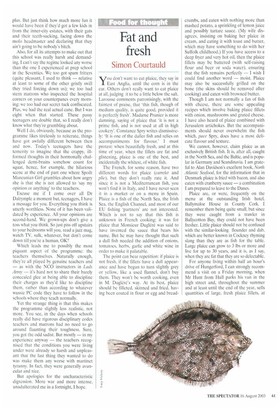Fat and fresh
Simon Courtauld
you don't want to eat plaice, they say in East Anglia, until the corn is in the ear. Others don't really want to eat plaice at all, judging it to be a little below the salt. Larousse comments patronisingly, with the faintest of praise, that 'this fish, though of medium quality, is quite good, provided it is perfectly fresh'. Madame Prunier is more damning, saying of plaice that 'it is not a prime fish, and is not used at all in high cookery'. Constance Spry writes dismissively: 'It is one of the duller fish and relies on accompaniments for flavour.' I must protest: when beautifully fresh, and at this time of year, when the fillets are fat and glistening, plaice is one of the best, and incidentally the whitest, of white fish.
The French, for some reason, have two different words for plaice (can-elet and plie), but they don't really rate it. And since it is not a Mediterranean fish, you won't find it in Italy, and I have never seen it in a market or on a menu in Spain. Plaice is a fish of the North Sea, the Irish Sea, the English Channel, and most of our EU fishing 'partners' are not interested. Which is not to say that this fish is unknown in French cooking; it was for plaice that Monsieur Duglere was said to have invented the sauce that bears his name. But he may have thought that such a dull fish needed the addition of onions, tomatoes, herbs, garlic and white wine in order to make it palatable.
The point can bear repetition: if plaice is not fresh, if the fillets have a dull appearance and have begun to turn slightly grey or yellow, like a used flannel, don't buy them. They won't be worth cooking, even in M. Duglere's way. At its best, plaice should be filleted, skinned and fried, having been coated in flour or egg and bread
crumbs, and eaten with nothing more than mashed potato, a sprinkling of lemon juice and possibly tartare sauce. (My wife disagrees, insisting on baking her plaice in cream, and eating it with toast and butter, which may have something to do with her Suffolk childhood.) If you have access to a deep fryer and very hot oil, then the plaice fillets may be battered (with self-raising flour and beer or soda water). ensuring that the fish remains perfectly — I wish I could find another word — moist. Plaice may also be successfully grilled on the bone (the skins should be removed after cooking) and eaten with browned butter.
Though I am not normally a fan of fish with cheese, there are some appealing recipes which involve baking plaice fillets with onion, mushrooms and grated cheese. I have also heard of plaice combined with Jerusalem artichokes. But the accompaniments should never overwhelm the fish which, pace Spry, does have a most delicate flavour and texture.
We cannot, however, claim plaice as an exclusively British fish. It is, after all, caught in the North Sea, and the Baltic, and is popular in Germany and Scandinavia. I am grateful to Alan Davidson's excellent book, North Atlantic Seafood, for the information that in Denmark plaice is fried with bacon, and also eaten with cranberry sauce — a combination I am prepared to leave to the Danes.
Plaice are, or were, frequently on the menu at the outstanding Irish hotel. Ballymaloe House in County Cork. I remember them being quite small, but since they were caught from a trawler in Ballycotton Bay, they could not have been fresher. Little plaice should not be confused with the similar-looking flounder and dab, which are better known in Cockney rhyming slang than they are as fish for the table. Large plaice can grow to 3 lbs or more and live for up to 30 years, and it is, as I say, when they are fat that they are so delectable.
For anyone living within half an hour's drive of Hungerford, I can strongly recommend a visit on a Friday morning, when Mr Hunt from Hull parks his van in the high street and, throughout the summer and at least until the end of the year, sells quantities of large, fresh plaice fillets, at the unbeatable price of 13.60 per lb. They may come from not far offshore in the North Sea, or from as far as the waters round Iceland. but they are always, as he rightly describes them, superb. These are decidedly not lower-class fish.











































































 Previous page
Previous page